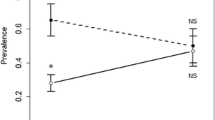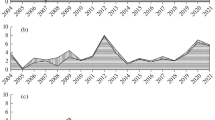Summary
-
1.
Bionomical and ecological investigations on bank voles were carried out by mark and release trapping in two phytosociologically different areas in Lower Austria from 1963 until 1966.
-
2.
The number of trappings and retrappings depends on the intensity of captures: 3 consecutive trapping nights in fourtnightly intervals appeared to be most favourable.
-
3.
The life time of bank voles was determined as 3.1 and respectively 3.6 months in the two localities investigated. Only very few specimens reach an age of one year or more.
-
4.
Bank voles prefer dense and covered habitats.
-
5.
The home range of females has an average area of about 500 m2, that of males of about 2000 m2. Sexually active males may cover even larger home ranges of 3000 m2 and more.
-
6.
The most abundant ectoparasites are larvae of chiggers and preadult stages of ticks, particularly larvae of Ixodes ricinus. The average infestation of bank voles with ticks is clearly correlated with the mobility of the former: more active individuals (males) are more highly infested. The density of infestation coincides with periods of maximum activity of the parasites.
Zusammenfassung
-
1.
Von 1963–1966 wurden an Hand von Markierungsfängen bionomische und ökologische Untersuchungen an Rötelmäusen zweier pflanzensoziologisch unterscheidbarer Gebiete in Niederösterreich durchgeführt.
-
2.
Die Zahl der Fänge und Wiederfänge ist abhängig von der “Fangintensität”: Am günstigsten erwiesen sich Zyklen von jeweils 3 aufeinanderfolgenden Fangnächten mit Intervallen von 14 Tagen.
-
3.
Die Lebenserwartung der Rötelmaus beträgt in den beiden Untersuchungsgebieten 3,1 bzw. 3,6 Monate. Nur ganz wenige Tiere erreichen ein Freilandlebensalter von 1 Jahr und darüber.
-
4.
Die Rötelmaus bevorzugt reich strukturierte und gedeckte Standorte.
-
5.
Der Aktionsraum der Weibchen beträgt im Durchschnitt etwa 500 m2, der der Männchen etwa 2000 m2. Sexuell aktive Männchen erreichen noch größre Aktionsräume von etwa 3000 m2 und mehr.
-
6.
Von den Ektoparasiten sind am häufigsten Trombiculidenlarven sowie präimaginale Stadien von Zecken, im besonderen Larven von Ixodes ricinus, an den Tieren schmarotzend anzutreffen. Der durchschnittliche Befall mit Zeckenlarven entspricht der Mobilität der Mäuse: aktivere Tiere (Männchen) haben höhere Befallszahlen aufzuweisen. Die Befallsdichte entspricht zeitlich dem Auftreten der Aktivitätsmaxima der Parasiten.
Similar content being viewed by others
Literatur
Andrzejewski, R.: Processes of incoming, settlement and disappearance of individuals and variation in the number of small rodents. Acta theriol. 7, 169–213 (1963).
—, and I. Głogowska: The influence of the lay-out of traps and length of time for which they remain set on the distribution of capture of small rodents. Ecologia polska, Ser. A 10, 282–293 (1962).
—, and J. Olszewski: Social behaviour and interspecific relations in Apodemus flavicollis (Melichor, 1834) and Clethrionomys glareolus (Schreber, 1780). Acta theriol. 7, 155–168 (1963).
—, and J. Waszkiewicz-Gliwicz: The trappability of Clethrionomys glareolus (Schreber, 1780) and other ecological parameters obtained by the CMR capture method. Ecologia polska, Ser. A 15, 709–725 (1967).
Blair, W. F.: Home ranges and populations of the meadow vole in southern Michigan. J. Wildlife Manag. 4, 149–161 (1940).
—: Population dynamics of rodents and other small mammals. Advanc. Genet. 5, 1–41 (1953).
Burt, H. W.: Territorial behavior and populations of some small mammals in southern Michigan. Misc. Publ. Mus. Zool. Univ. Mich. 45, 1–58 (1940).
—: Territoriality and home range concepts as applied to mammals. J. Mammal. 24, 346–352 (1943).
Daniel, M.: The seasonal dynamics of the infestation of small mammals by Chigger Larvae in a Lowland forest of periodically inundated area. Věstn. čs. Zool. Společ. 22, 156–179 (1958).
Kožuch, O., M. Greŝíková, J. Nosek, M. Lichard, and M. Sekeyova: The role of small rodents and hedgehogs in a natural focus of tick-borne encephalitis. Bull. Wld Hlth Org. 36, Suppl. 1, 61–66 (1967).
Kulicke, H., Aktionsraum und Revierverhalten bei Erdmaus (Microtus agrestis L.) und Rötelmaus (Clethrionomys glareolus Schreb.). Symp. Theriol. Brno 1960, 195–200 (1960).
Nosek, J., and I. Grulich: The relationship between the tick-borne encephalitis virus and the ticks and mammals of the Tribeč Mountain Range. Bull. Wld Hlth Org. 36, Suppl. 1, 31–47 (1967).
Pelikán, J.: Beitrag zur Bionomie der Population einiger Kleinsäuger. [Tschech.] Rozpr. ces. akad. ved. 65, 1–63 (1955).
—, and J. Zejda: Comparison of two methods of estimating small mammal populations. Zool. Listy 11, 227–242 (1961).
——: On the question of investigating small mammal populations by the quadrate method. Acta theriol. 11, 1–24 (1964).
Petersen: Zur Ökologie schleswig-holsteinischer Kleinsäuger. Ref. Ges. Säugetierkde. Wien 1964.
Pretzmann, G., A. Radda u. J. Loew: Studien zur Ökologie von Ixodes ricinus L. in einem Endemiegebiet der Frühsommermeningoencephalitis (FSME) im Bezirk Neunkirchen (Niederösterreich). Z. Morph. Ökol. Tiere 54, 393–413 (1964).
Radda, A.: Die Rolle einiger Muriden und deren häufigster Ektoparasiten im natürlichen Kreislauf des Virus der Zentraleuropäischen Encephalitis. Diss. Wien (1965).
— u. K. Zukrigl: Beitrag zur Kenntnis der Syn-Ökologie des Virus der Zentraleuropäischen Encephalitis. Zbl. Bakt., I. Abt. Orig. 202, 273–296 (1967).
Radda, A. G. Pretzmann, and H. M. Steiner: Field investigations on the ecology of Tick-borne Encephalitis (TBE-CEE)-virus in Lower Austria. J. of HEMI, im Druck (1968).
Reichstein, H.: Populationsstudien an Erdmäusen, Microtus agrestis L. (Markierungsversuche). Zool. Jb., Abt. System., Ökol. u. Geogr. 86, 267–382 (1959).
—: Untersuchungen zum Aktionsraum und zum Revierverhalten der Feldmaus Microtus arvalis (Pall.) — Markierungsversuche. Z. Säugetierk. 25, 150–169 (1960).
Southern, H. N.: The handbook of British mammals. Oxford 1964.
Stein, C. H. W.: Natürliche Auslese bei der Rötelmaus (Clethrionomys glareolus Schr.). Z. Säugetierk. 21, 84–100 (1956).
Wencl, J.: Zur Frage der Frühsommer-Meningo-Encephalitis (ESME) in Österreich. Mitt. forstl. Bundesversuchsanstalt, Mariabrunn, Wien 1965.
Zejda, I.: Die Analyse der Frühlingspopulation der Rötelmaus in der Hohen Tatra (1955). Zool. Listy 4, 303–328 (1955).
—: Age structure in populations of the bank vole, Clethrionomys glareolus Schreber, 1780. Zool. Listy 24, 249–264 (1961).
—: Winter breeding in the bank vole Clethrionomys glareolus Schreb. Zool. Listy 4, 309–324 (1962).
—: Development of several populations of the bank vole, Clethrionomys glareolus Schreb., in a peak year. Zool. Liyst 13, 15–30 (1964).
Author information
Authors and Affiliations
Rights and permissions
About this article
Cite this article
Radda, A. Populationsstudien an Rötelmäusen (Clethrionomys glareolus Schreber, 1780) durch Markierungsfang in Niederösterreich. Oecologia 1, 219–235 (1968). https://doi.org/10.1007/BF00383139
Received:
Issue Date:
DOI: https://doi.org/10.1007/BF00383139




